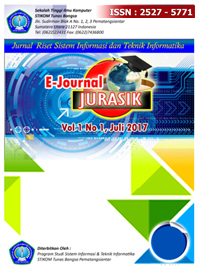Model Antrian Prioritas Pelayanan Perawatan Kesehatan Cerdas
Abstract
Full Text:
PDFReferences
S. P. Mohanty, U. Choppali, and E. Kougianos, “Everything you wanted to know about smart cities,” IEEE Consum. Electron. Mag., vol. 5, no. 3, pp. 60–70, 2016.
F. Casino, C. Patsakis, E. Batista, O. Postolache, A. Martínez-Ballesté, and A. Solanas, “Smart Healthcare in the IoT Era: A Context-Aware Recommendation Example,” in 2018 International Symposium in Sensing and Instrumentation in IoT Era, ISSI 2018, 2018.
S. M. Riazul Islam, Daehan Kwak, M. Humaun Kabir, M. Hossain, and Kyung-Sup Kwak, “The Internet of Things for Health Care: A Comprehensive Survey,” IEEE Access, vol. 3, pp. 678–708, 2015.
B. P., C. G., C. A., and F. L., “Convergence of MANET and WSN in IoT urban scenarios,” IEEE Sens. J., 2013.
N. Walravens and P. Ballon, “Platform business models for smart cities: From control and value to governance and public value,” IEEE Commun. Mag., 2013.
A. Alaiad and L. Zhou, “Patients’ adoption of WSN-Based smart home healthcare systems: An integrated model of facilitators and barriers,” IEEE Trans. Prof. Commun., vol. 60, no. 1, pp. 4–23, 2017.
L. Lapointe, J. Ramaprasad, and I. Vedel, “Collaborating through social media to create health awareness,” in Proceedings of the Annual Hawaii International Conference on System Sciences, 2013, pp. 792–801.
A. Solanas et al., “Smart health: A context-aware health paradigm within smart cities,” IEEE Commun. Mag., vol. 52, no. 8, pp. 74–81, 2014.
I. Adan and J. Resing, “Queueing Theory,” Technology, vol. 15, no. x, p. 180, 2002.
I. R. S. Robertson-Steel, “Evolution of triage systems,” Emergency Medicine Journal. 2006.
W. S. Pérez, M. Gómez Muñoz, E. Bragulat, and A. Álvarez, “Triage: A key tool in emergency care,” An. Sist. Sanit. Navar., 2010.
M. Christ, F. Grossmann, D. Winter, R. Bingisser, and E. Platz, “Modern triage in the emergency department.,” Dtsch. Arztebl. Int., 2010.
B. Lima and J. P. Faria, “Towards real-time patient prioritization in hospital emergency services,” in 2018 IEEE 20th International Conference on e-Health Networking, Applications and Services, Healthcom 2018, 2018.
A. M. H. Pardede et al., “Framework For Patient Service Queue System For Decision Support System on Smart Health Care,” Int. J. Eng. Technol., vol. 7, no. 2.13, pp. 337–340, 2018.
DOI: http://dx.doi.org/10.30645/senaris.v1i0.127
Refbacks
- There are currently no refbacks.
 








